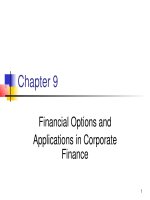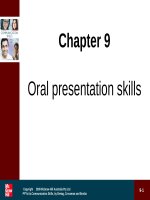Lecture Consumer behaviour: Chapter 9 - Cathy Neal, Pascale Quester, Del Hawkins
Bạn đang xem bản rút gọn của tài liệu. Xem và tải ngay bản đầy đủ của tài liệu tại đây (1.85 MB, 28 trang )
Chapter 9 Learning and Memory
• How we (and consumers) learn
• Types of learning
• Main characteristics of learning
• Using learning in marketing strategies
• Importance of brand image and product positioning
Copyright ª 2004 McGrawHill Australia Pty Ltd
9–1
Learning
• Learning refers to any change in the content or
organisation of long-term memory
• Consumer behaviour is largely learned behaviour
Copyright ª 2004 McGrawHill Australia Pty Ltd
9–2
Learning as a Key to Consumer Behaviour
9–3
Learning Results from Information
Processing and Causes Changes in
Memory
9–4
Involvement and Learning
• Learning under high-involvement conditions
–
consumer has a high motivation to learn
• Learning under low-involvement conditions
–
most consumer learning is in a low-involvement context
Copyright ª 2004 McGrawHill Australia Pty Ltd
9–5
Learning Theories in High- and LowInvolvement Situations
9–6
Types of Learning
• Conditioning
–
–
classical conditioning
operant conditioning
• Cognitive learning
–
–
–
iconic rote learning
vicarious learning/modelling
reasoning
Copyright ª 2004 McGrawHill Australia Pty Ltd
9–7
Conditioning
Conditioning is based on the association of a stimulus
(information) with a response (behaviour or feeling)
Copyright ª 2004 McGrawHill Australia Pty Ltd
9–8
Classical Conditioning
• Establishing a relationship between stimulus and
response to bring about the learning of the same
response to a different stimulus
• Most common in low-involvement situations
• Learning is more often a feeling or emotion than
information
Copyright ª 2004 McGrawHill Australia Pty Ltd
9–9
Consumer Learning through Classical Conditioning
9–10
How Affective Response Leads
to Learning
9–11
Operant Conditioning
•
Trial precedes liking
– reverse is often true for classical conditioning
– product sampling is an example of this type of learning
9–12
The Process of Shaping in Purchase Behaviour
9–13
An Advertisement Designed to Induce Trial
9–14
Cognitive Learning
• Iconic rote learning
–
association between two or more concepts in the absence
of conditioning
a substantial amount of low-involvement learning involves
iconic rote learning
achieved by repeated advertising messages
Copyright ª 2004 McGrawHill Australia Pty Ltd
9–15
Cognitive Learning (cont.)
• Vicarious learning/modelling
–
observe others' behaviour and adjust their own
accordingly
common in both high-involvement and low- involvement
situations
• Reasoning
–
most complex form of cognitive learning
most high-involvement decisions generate some reasoning
Copyright ª 2004 McGrawHill Australia Pty Ltd
9–16
An Advertisement Using Reasoning
9–17
General Characteristics of Learning
• The strength of learning is influenced by:
–
importance
–
–
–
–
–
separates high- and low-involvement learning situations
involvement
mood
reinforcement
stimulus repetitions (practice sessions)
imagery
Copyright ª 2004 McGrawHill Australia Pty Ltd
9–18
General Characteristics of Learning
(cont.)
• Extinction
–
forgetting occurs when reinforcement for learning is
withdrawn
• Stimulus generalisation
–
–
brand equity
brand leverage
Copyright ª 2004 McGrawHill Australia Pty Ltd
9–19
Spontaneous Awareness: Brand A
9–20
Spontaneous Awareness: Brand B
9–21
General Characteristics of Learning
(cont.)
• Stimulus discrimination
–
why your brand is different
• Response environment
–
–
strength of original learning
similarity of original learning environment to the retrieval
environment
Copyright ª 2004 McGrawHill Australia Pty Ltd
9–22
The Response Environment
• Strength of original learning affects ability to
retrieve relevant information
• Similarity of the original learning and the type of
learning is important
• Marketers aim to replicate these situations
Copyright ª 2004 McGrawHill Australia Pty Ltd
9–23
Example of Stimulus Generalisation to Launch a
New Product
9–24
Memory
• Memory is the total accumulation of
prior learning experiences
• Short-term memory
–
–
working memory
the role of images, sight, sound, smell, taste and tactile
situations
Copyright ª 2004 McGrawHill Australia Pty Ltd
9–25









